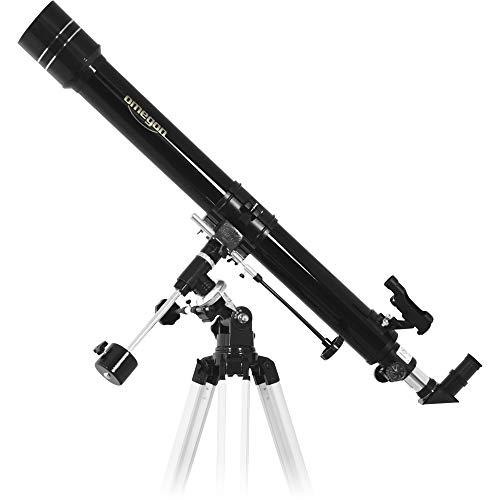Description
The Omegon 70/900 EQ-1 telescope is perfect for starting to observe the night sky. You can observe the moon, stars and planets, tracking them easily with the astronomical mount. Suitable for all night owls who have always wanted to directly experience the secrets of the universe.
The AC 70/900 optics: With an aperture of 70mm, this refractor collects 100 times as much light as the naked eye alone, and also substantially more light than classical beginner's telescopes with apertures of only 60mm. This also means it has a higher resolution and with a maximum magnification of 140X will already show you the first details when observing the large disc planets Saturn, Jupiter and Mars. Also, it is well worthwhile observing the moon; here you can beautifully observe the ever-changing cratered moonscape which, depending on the phase, always appears different. Nature watching in daylight is also possible with an erecting lens or an amici prism. Focusing takes place by means of a focus wheel on the rack-and-pinion focuser. So the sharpness can always be precisely adjusted and remains reliably fixed during the observation.
The advantages in a nutshell:
- easily set up in a few minutes
- collects 36% more light than a 60mm telescope
- very clear and high-contrast image
- 1.25 focuser for all standard eyepieces
The EQ-1Mount:
This parallactic mount provides the possibility of accurately aligning the optics to the Pole Star. The correct polar elevation
The AC 70/900 optics: With an aperture of 70mm, this refractor collects 100 times as much light as the naked eye alone, and also substantially more light than classical beginner's telescopes with apertures of only 60mm. This also means it has a higher resolution and with a maximum magnification of 140X will already show you the first details when observing the large disc planets Saturn, Jupiter and Mars. Also, it is well worthwhile observing the moon; here you can beautifully observe the ever-changing cratered moonscape which, depending on the phase, always appears different. Nature watching in daylight is also possible with an erecting lens or an amici prism. Focusing takes place by means of a focus wheel on the rack-and-pinion focuser. So the sharpness can always be precisely adjusted and remains reliably fixed during the observation.
The advantages in a nutshell:
- easily set up in a few minutes
- collects 36% more light than a 60mm telescope
- very clear and high-contrast image
- 1.25 focuser for all standard eyepieces
The EQ-1Mount:
This parallactic mount provides the possibility of accurately aligning the optics to the Pole Star. The correct polar elevation




